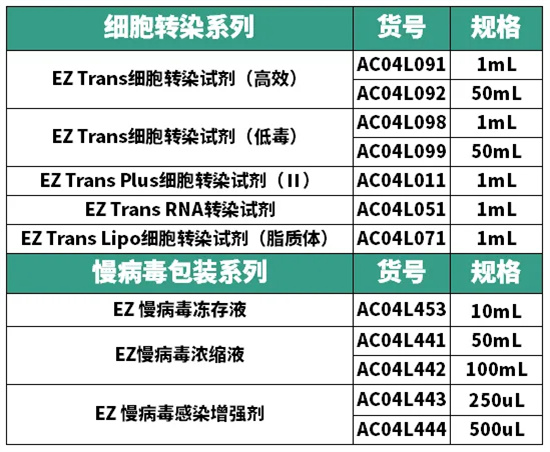Application scenario of lentiviral vector in animal disease model construction (in vivo application of lentivirus)
The establishment of animal models plays a crucial role in scientists delving deeper into the mechanisms of disease occurrence。By simulating diseases or genetic mutations in animal models, the pathogenesis of human diseases can be simulated, revealing the pathological, physiological, molecular, and genetic mechanisms of diseases。Meanwhile, animal models can also be used to evaluate the efficacy and safety of potential drugs, providing important references for the development of new drugs. By conducting drug therapy trials on animal models, the therapeutic effects, dose-response, drug metabolism, and toxic reactions of drugs on diseases can be evaluated, providing important reference for preclinical drug screening and development.
adoptSlow virus mediated gene transfer,Animal models with specific genotypes, such as gene knockout, overexpression, or mutation, can be constructed, and disease models can also be constructed to simulate the occurrence and development of human diseases for disease mechanism research and drug screening. There are various application scenarios for lentiviral vectors in animal disease model construction. Today, let's explore the in vivo application of lentiviruses with the editor.
1、 Intratumoral injection
❤Article Title:METTL3-Mediated LINC00475 AlternativeSplicing Promotes Glioma Progression byInducing Mitochondrial Fission
❤Publishing journals:Research (Washington, D.C.)
❤Author's affiliation:Guangzhou Medical University
Mitochondrial division promotes the progression of glioma, but the function and regulatory mechanism of lncRNAs in mitochondrial division are still unclear. In this article, the author found that compared to normal brain tissue, LINC00475 has been proven to be overexpressed in gliomas, with a higher frequency of variable splicing and a poorer prognosis.In vitro and animal tumor formation experiments have shown that LINC00475-S has a significantly stronger effect on the proliferation, metastasis, autophagy, and mitochondrial division of glioma cells than LINC00475.Mechanistically speaking, METTL3 induces the production of LINC00475-S by splicing LINC00475 through m6A modification, and then promotes mitochondrial division of glioma cells by inhibiting the expression of MIF. Pull down combined with LC/MS and RIP found that m6A recognized protein HNRNPH1 binding to the GYR and GY domains of LINC00475 and promoting LINC00475 splicing. METTL3 promotes the binding of HNRNPH1 to LINC00475 in an m6A dependent manner, thereby inducing the production of LINC00475-S. METTL3 promotes variable splicing of LINC00475 mediated by HNRNPH1, promoting glioma progression by inducing mitochondrial division. Variable splicing and m6A editing targeting LINC00475 can serve as therapeutic strategies for combating glioma.

Figure 1. Enhanced tumorigenic potential of U251 when overexpressing LINC00475-S
☆ The author utilized lentiviral vectors toIntratumoral injection(5.0E+06 TU/piece, once every 2 weeks)Overexpression of LINC00475 and LINC00475-S in tumor tissue.
Harmony with MetabiologyI am fortunate to provide packaging services for the gene overexpression virus mentioned in this article。
2、 Intratracheal injection
❤Article Title:A novel protein RASON encoded by a lncRNA controls oncogenic RAS signaling in KRAS mutant cancers
❤Publishing journals:Cell Research
❤Author's affiliation: Nanjing University
The LSL KrasG12D; Trp53 R172H/+(KP mouse) lung cancer model is a genetic mouse model commonly used to study Kras driven tumorigenesis. KrasG12D is a common activated mutant of the Kras gene in human tumors, and Trp53 R172H is a mutant of the p53 gene. Insert a loop stop loxp termination sequence between the coding region and promoter of these two genes, which do not express mutant proteins in the absence of Cre recombinase; When mating with tissue-specific Cre, it can lead to the loss of the transcription termination sequence loxp Stop loxp, resulting in the expression of oncogenic proteins.
In this article,The author achieved the knockout of Rason and activation of Kras/p53 alleles in the lungs by injecting lentiviral constructs containing Cre, Cas9, and Rason sgRNAs into the trachea。The incidence and size of lung tumors were monitored using mircoCT, and the results showed that Rason knockout significantly inhibited the formation of lung tumors in KP mice and significantly prolonged their survival. The above results suggest a common mechanism of Rason promoting tumor function in Kras mutant tumors.

Figure 2. Rason knockout significantly inhibits the formation of lung tumors in KP mice
☆ The author utilized a lentiviral vector containing Cre, Cas9, and Rason sgRNA, using gasIntratubular injection(1.0E+05 TU/only)Simultaneously achieving the knockout of Rason and activation of Kras/p53 alleles in the lungs.
Harmony with MetabiologyI am fortunate to provide the slow virus packaging service mentioned in this article.
3、 Intrathecal injection
❤Article Title:Activation of GDNF-ERK-Runx1 signaling contributes to P2X3R gene transcription and bone cancer pain
❤Publishing journals:iScience
❤Author's affiliation: Peking University
Bone cancer pain is a common symptom in patients with bone metastases, and its underlying mechanisms are not yet clear. In this article, the author reported that Runx1 directly upregulates the transcriptional activity of the P2X3 receptor (P2X3R) gene promoter in PC12 cells. Knocking down Runx1 in dorsal root ganglion (DRG) neurons inhibits functional upregulation of P2X3R, reducing neuronal overexcitation and pain hypersensitivity in tumor bearing rats; andOverexpression of Runx1 promotes P2X3R gene transcription in DRG neurons, inducing neuronal overexcitation and pain hypersensitivity in naive rats。The activation of GDNF-GFR α 1-Ret-ERK signal transduction is necessary for Runx1 mediated P2X3R gene transcription in DRG neurons and contributes to neuronal overexcitation and pain hypersensitivity in tumor bearing rats. These findings suggest that Runx1 mediated P2X3R gene transcription induced by GDNF-GFR α 1-Ret-ERK signal activation contributes to the sensitization of DRG neurons and the pathogenesis of bone cancer pain. The author's research findings have identified a potential targeting mechanism that may lead to bone metastasis related pain in cancer patients.

Figure 3. Overexpression of Runx1 in DRG neurons promotes P2X3R gene transcription and protein expression
☆ The author utilized lentiviral vectors toIntrathecal injection(5.0 E+08 TU/mL,20 ul)Overexpression of Runx1 in DRG neurons and obtaining DRG tissue 14 days after virus injection.
Harmony with MetabiologyI am fortunate to provide packaging services for the gene overexpression virus mentioned in this article.
4、 Intravitreal injection
❤Article Title:ALKBH5-Mediated m6A Modification of A20 Regulates Microglia Polarization in Diabetic Retinopathy
❤Publishing journals:Frontiers in Immunology
❤Author's affiliation: Sun Yat sen University
In this paper, the authors found that the M1 polarization rate of retinal microglia in diabetes rats was higher, and the M2 polarization rate was lower. As glucose concentration increases, microglia tend to polarize into M1 type. Through RNA sequencing, glucose treated microglia showed a differentially expressed gene profile enriched in various inflammatory categories and pathways. The lower expression of A20 in microglia after glucose treatment indicates its negative regulation of M1 polarization. In addition,Vitreous injection of A20 overexpression lentivirus (OE-A20) corrected the enhanced polarization of M1 retinal microglia in diabetes rats。The m6A demethylase ALKBH5 mediates an increase in m6A modification and accelerates A20 degradation in glucose treated microglia. This study not only provides a new perspective for the pathogenesis of diabetes retinopathy, but also provides a new perspective for the diagnosis and treatment of diabetes retinopathy.

Figure 4. Intravitreal injection of A20 overexpression lentivirus can correct the increased M1 polarization of retinal microglia in diabetes rats
☆ The author utilized lentiviral vectors toIntravitreal injection(1.0E+09 TU,10 ul)Overexpression of A20 in the eye.
Harmony with MetabiologyI am fortunate to provide packaging services for the gene overexpression virus mentioned in this article.
5、 Inguinal lymph node injection
❤Article Title:Fibroblastic reticular cells in lymph node potentiate white adipose tissue beiging through neuro-immune crosstalk in male mice
❤Publishing journals:Nature Communications
❤Author's affiliation: University of Hong Kong
Lymph nodes (LN) are typically embedded in metabolically active white adipose tissue (WAT), and their functional relationships remain unclear. In this article,The author found that fibroblast reticulum cells (FRC) and subcutaneous adipose tissue (scWAT) in inguinal LN (iLN) are the main sources of cold induced beige response and thermogenic IL-33。Mechanistically, the cold enhanced sympathetic nervous system flows out to iLN to activate β 1 and β 2 adrenergic receptor (AR) signaling in FRC, promoting the release of IL-33 into the scWAT surrounding iLN. IL-33 activates type 2 immune response to enhance the biogenesis of beige adipocytes. Selective ablation of sympathetic innervation of IL-33 or β 1 and β 2-AR or iLN in FRC can eliminate cold induced scWAT beige response, while IL-33 supplementation can reverse damaged cold induced beige response in iLN deficient mice. In summary, this study reveals the unexpected role of FRC in mediating neuroimmune interactions to maintain energy homeostasis in iLN.

Figure 5. Intrainguinal lymph node injection of lentivirus specific knockout of IL-33 in FRC
☆ The author utilized lentiviral vectors in IL-33fl/fl miceInguinal lymph node injection(7.5E+06 TU/only)Slow viruses containing specific promoters Ccl19 and Cre were used to achieve specific knockout of IL-33 in FRC cells in iLN.
Harmony with MetabiologyI am fortunate to provide packaging services for the gene overexpression virus mentioned in this article。
6、 Live imaging
❤Article Title:Hypoxia-induced circRNF13 promotes the progression and glycolysis of pancreatic cancer
❤Publishing journals:Experimental & Molecular Medicine
❤Author's affiliation: Shanghai Jiao Tong University
Pancreatic cancer (PC) is one of the most malignant tumors. Rapid progression and distant metastasis are the main causes of patient death. Hypoxia is a hallmark of various cancers and is related to tumor biology. However, little is known about the role of circRNA in glycolysis and hypoxia mediated progression of PC. Here, the author used RNA sequencing to analyze the expression of hypoxia related circRNAs and discovered a unique circRNA called circRNF13 upregulated in PC tissue, which may be a potential prognostic indicator. HIF-1 α and EIF4A3 are involved in regulating the biogenesis of circRNF13. In addition, circRNF13 has been validated to have stimulating effects on cell proliferation, angiogenesis, invasion, and glycolysis. Importantly, the author found that circRNF13 increases PDK3 levels by acting as a miR-654-3p sponge, thereby promoting the malignant process of PC. The above research results indicate that hypoxia induced circRNF13 mediated by HIF-1 α and EIF4A3 promotes tumor progression and glycolysis in PC, indicating the potential of circRNF13 as a prognostic biomarker and therapeutic target for PC.

Figure 6. CircRNF13 may promote the metastasis of pancreatic cancer as a carcinogen
☆ The author passedCaudal veinHuman pancreatic cancer cells overexpressing circRNF13 sequence and Luciferase coding sequence constructed by lentivirus and interfering circRNF13 sequence and Luciferase coding sequence were injected respectively, and bioluminescence in vivo imaging was performed every 2 weeks to observe the metastasis of tumor cells in vivo.
Harmony with MetabiologyI am fortunate to provide packaging services for the gene overexpression virus mentioned in this article.
Heyuan Li Ji Popular Reagents















 Back
Back
 Back
Back

































